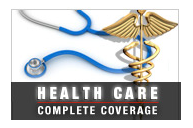The Obamacare health insurance exchanges have arrived, allowing consumers to enroll for coverage that begins Jan. 1. Available in each state and the District of Columbia, the online insurance marketplaces are expected to provide health care plans -- often at discounted, subsidized prices -- to an estimated 7 million people in 2014, according to the Congressional Budget Office.
Here's how to navigate your new options.
"All the plans offered in the health insurance marketplace are going to cover basically the same set of services, which really helps the consumer," says Lynn Quincy, senior health policy analyst for Consumers Union, the policy and advocacy arm of Consumer Reports. "They can look at how the plans vary by premium and how the plans vary by the expected amount of out-of-pocket costs to the consumer."
All exchange plans must cover a list of "essential health benefits," including hospitalization and outpatient, emergency and laboratory services. But consumers may find big differences in monthly premiums, deductibles and copays.
"The tendency, I think, is for people to just consider the premium, but it's important to look at the deductible and know that this is the amount you're going to have to pay for certain services before the plan begins to pay for those services," says Dara Chadwick, spokeswoman for HealthSource RI, the Rhode Island health insurance exchange.
RELATED: 5 OBAMACARE PROBLEMS THAT SHOULD HAVE BEEN FIXED
Plans come in four "metallic" coverage levels: bronze, silver, gold and platinum. Bronze plans will tend to have the lowest premiums and will cover 60 percent of a person's health care costs, on average. Platinum plans will tend to have the highest premiums but will cover an average 90 percent of the costs. Silver and gold plans, in the middle, will cover 70 and 80 percent, respectively.
To help with comparison shopping, insurance companies must provide a "summary of benefits" document that outlines a plan's costs and coverage limitations and uses a couple of illustrations, showing how each plan would cover the birth of a baby or managing Type 2 diabetes. Consumers can pay for plans using personal checks, cashier's checks, money orders, wire transfers or prepaid debit cards.
CONSIDER NETWORKS AND DRUG BENEFITS
While comparing costs, consumers also should examine a plan's network of doctors, specialists and health care facilities. Out-of-network services could be substantially pricier than those that are in-network, notes Quincy.
"In many plans, but not all, there's just a single network, and if you use a doctor or a hospital inside the network, you face a given cost," she explains. "There are some newer plans that have what's called 'tiered pricing,' where there's more than one tier of provider inside the network."
In a tiered network, certain doctors and health care facilities are discounted more than others. When evaluating the potential costs of an Obamacare plan, Quincy recommends that you make sure doctors and facilities you regularly use are in-network.
Prescription drug coverage can vary between plans, too. Plans in the health insurance exchanges are required to cover a minimum of at least one medication for each officially recognized category and class of drug in the U.S., but they are not required to cover specific brand-name medications.
RELATED: THE GREAT OBAMACARE WORKFORCE EXODUS
If you're currently on a prescription, figuring out whether it's covered under an exchange plan could be tricky, says Dan Schuyler, director of health insurance exchange technology for Leavitt Partners, a consulting firm that has advised states on how to set up their insurance marketplaces.
"From the intelligence we've gathered, a majority of the exchanges … will not have a really intuitive search function for prescription drugs, so the consumer will have to really drill down into the prescription drug benefit to find out what's covered," Schuyler says.
He advises consumers to contact plans to ask about specific drug coverage.
Before signing up, you may want to research the insurance company itself. Quincy says all companies in the exchanges have been vetted for quality. Both URAC (formerly the Utilization Review Accreditation Commission) and the National Committee for Quality Assurance, or NCQA, offer accreditation information on more established health insurers, but that info won't be available on new providers.
SEEK SUBSIDIES, AND KNOW HELP IS AVAILABLE
Under the Affordable Care Act, those earning up to 400 percent of the federal poverty level -- that's $45,960 for an individual or $94,200 for a family of four -- and who do not have access to affordable health insurance through their employer are eligible for tax credits to lower the cost of exchange plans.
RELATED: OBAMACARE CHECKUP: WILL YOUR PREMIUMS RISE OR FALL
Consumers either can pay for their plan in full and receive the credit at tax time, or can opt for an "advanced subsidy" that will immediately lower their health care premiums. To receive the advance, you must estimate your income. If you're off, you might have to pay back some of your premium discount.
"If people have the type of job where it's difficult to predict income, they can avoid this possibility of having to repay any excess by simply saying, 'Well I want to take some of my estimated tax credit in advance but not all of it,'" notes Quincy.
If you have questions about subsidies, insurance applications or comparing plans, Obamacare's overseers have help available at (800) 318-2596, or via live chat at HealthCare.gov. "Navigators" will be available in the states to explain consumers' options and help them fill out paper and electronic applications and verify eligibility for subsidies.
"We're really encouraging anyone who has not had health insurance to get in touch and really speak with someone about their particular situation," says Chadwick, with the Rhode Island health insurance exchange.
This piece originally appeared at Bankrate.com.





